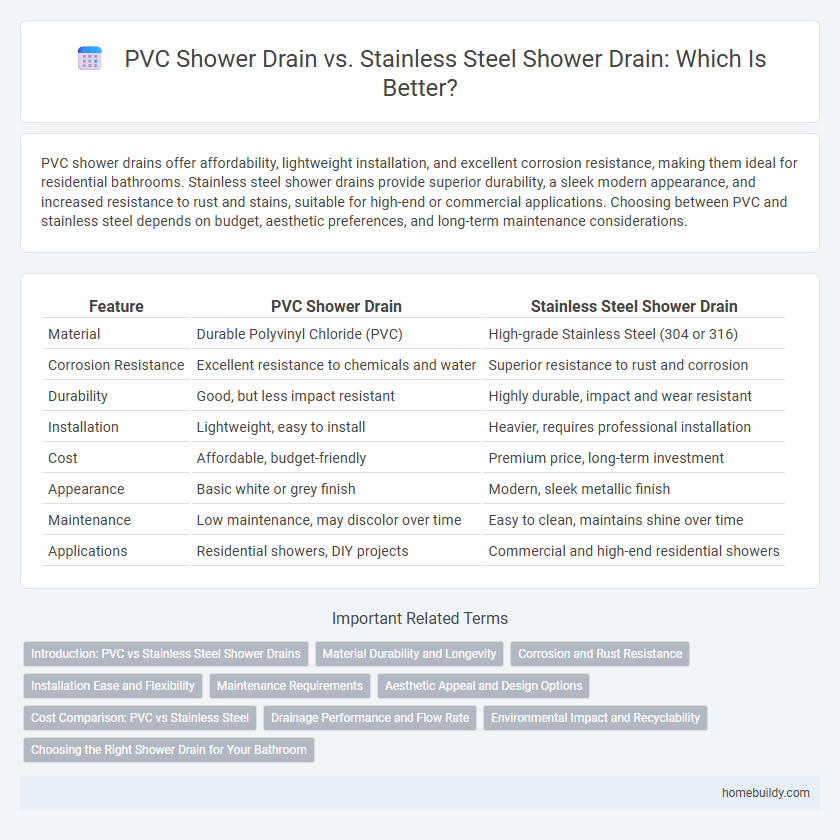PVC shower drains offer affordability, lightweight installation, and excellent corrosion resistance, making them ideal for residential bathrooms. Stainless steel shower drains provide superior durability, a sleek modern appearance, and increased resistance to rust and stains, suitable for high-end or commercial applications. Choosing between PVC and stainless steel depends on budget, aesthetic preferences, and long-term maintenance considerations.
Table of Comparison
| Feature | PVC Shower Drain | Stainless Steel Shower Drain |
|---|---|---|
| Material | Durable Polyvinyl Chloride (PVC) | High-grade Stainless Steel (304 or 316) |
| Corrosion Resistance | Excellent resistance to chemicals and water | Superior resistance to rust and corrosion |
| Durability | Good, but less impact resistant | Highly durable, impact and wear resistant |
| Installation | Lightweight, easy to install | Heavier, requires professional installation |
| Cost | Affordable, budget-friendly | Premium price, long-term investment |
| Appearance | Basic white or grey finish | Modern, sleek metallic finish |
| Maintenance | Low maintenance, may discolor over time | Easy to clean, maintains shine over time |
| Applications | Residential showers, DIY projects | Commercial and high-end residential showers |
Introduction: PVC vs Stainless Steel Shower Drains
PVC shower drains offer corrosion resistance and affordability, making them ideal for budget-conscious bathroom renovations. Stainless steel shower drains provide superior durability, a sleek appearance, and enhanced resistance to stains and odors, suitable for high-end or commercial bathrooms. Choosing between PVC and stainless steel depends on factors like installation environment, maintenance preferences, and long-term investment.
Material Durability and Longevity
PVC shower drains offer excellent corrosion resistance and affordability but may degrade over time when exposed to UV light and extreme temperatures. Stainless steel shower drains provide superior durability, resisting rust, corrosion, and physical impacts, which ensures a longer lifespan in both residential and commercial bathrooms. The choice between PVC and stainless steel depends on budget constraints and the desired longevity for shower drain installations.
Corrosion and Rust Resistance
PVC shower drains offer excellent corrosion and rust resistance due to their non-metallic composition, making them ideal for wet environments and reducing maintenance needs. Stainless steel shower drains provide high durability and corrosion resistance, especially grades like 304 or 316 stainless steel, which resist rust even in prolonged exposure to moisture. While stainless steel offers superior strength and aesthetic appeal, PVC remains a cost-effective, corrosion-proof alternative for shower drainage systems.
Installation Ease and Flexibility
PVC shower drains offer superior installation ease due to their lightweight nature and compatibility with various pipe systems, making them ideal for DIY projects and quick replacements. Stainless steel shower drains provide greater flexibility in design customization and durability, but often require professional installation because of their weight and the need for specialized tools. Choosing between PVC and stainless steel depends on balancing ease of installation with long-term performance and aesthetic preferences.
Maintenance Requirements
PVC shower drains require minimal maintenance due to their resistance to corrosion, mold, and rust, making them easy to clean and ideal for humid bathroom environments. Stainless steel shower drains demand more regular upkeep to prevent water spots and potential rust if not properly maintained, especially in areas with hard water. Both materials benefit from routine debris removal to avoid clogging, but PVC offers a lower-maintenance solution for long-term durability.
Aesthetic Appeal and Design Options
PVC shower drains offer versatility in design with smooth finishes ideal for blending discreetly into various bathroom styles, making them a cost-effective choice for aesthetic customization. Stainless steel shower drains stand out with their sleek, modern look and superior durability, often featuring polished or brushed finishes that complement contemporary and industrial bathroom designs. The choice between PVC and stainless steel impacts both the visual appeal and design flexibility, with stainless steel providing a high-end, long-lasting aesthetic while PVC allows for a broader range of styles at a lower price point.
Cost Comparison: PVC vs Stainless Steel
PVC shower drains typically cost between $10 and $50, making them a budget-friendly option for most homeowners. Stainless steel shower drains range from $50 to $150 or more, reflecting their durability and corrosion resistance. The initial investment in stainless steel offers long-term savings by reducing the need for replacements and maintenance compared to PVC alternatives.
Drainage Performance and Flow Rate
PVC shower drains offer excellent corrosion resistance and a smooth interior surface that enhances water flow, resulting in efficient drainage performance. Stainless steel shower drains provide superior durability and strength, maintaining consistent flow rates under heavy usage due to their rigid structure. Both materials support high flow rates, but stainless steel typically excels in longevity and resistance to physical damage, ensuring reliable drainage over time.
Environmental Impact and Recyclability
PVC shower drains are less environmentally friendly due to their production from non-renewable petroleum resources and challenges in recycling, often ending up in landfills. Stainless steel shower drains offer superior sustainability with high recyclability, a longer lifespan, and reduced environmental impact from manufacturing processes. Choosing stainless steel reduces plastic waste and supports circular economy practices through efficient metal recycling.
Choosing the Right Shower Drain for Your Bathroom
Choosing the right shower drain involves evaluating durability, maintenance, and water flow efficiency. PVC shower drains offer affordability, corrosion resistance, and easy installation, making them ideal for most residential bathrooms. Stainless steel drains provide superior strength, long-term durability, and a sleek appearance, fitting well in high-traffic or upscale bathroom environments where longevity and aesthetics are priorities.
PVC shower drain vs stainless steel shower drain Infographic

 homebuildy.com
homebuildy.com